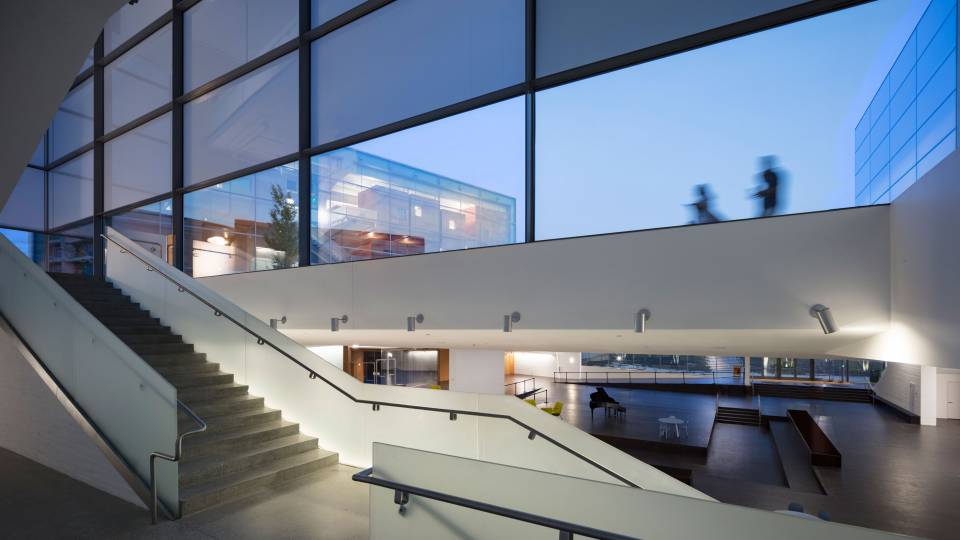Construction for a new installation about Woodrow Wilson will begin June 2019 on Scudder Plaza beside Robertson Hall, home of the Woodrow Wilson School of Public and International Affairs. Designed by acclaimed artist Walter Hood, the piece measures 39 feet in height and will be erected adjacent to the "Fountain of Freedom" on the Washington Road side of the plaza. The project is expected to be completed by September 2019. The installation, “Double Sights,” will be a vertical sculpture of two columnar elements, one leaning on the other, wrapped with surfaces of black and white stone and etched with quotations representing both the positive and negative aspects of Wilson’s legacy.
Construction for a new installation about Woodrow Wilson will begin June 2019 on Scudder Plaza beside Robertson Hall, home of the Woodrow Wilson School of Public and International Affairs.

Walter Hood of Hood Design Studio has designed an installation about the complex legacy of Woodrow Wilson.
Designed by acclaimed artist Walter Hood, the piece measures 39 feet in height and will be erected adjacent to the "Fountain of Freedom" on the Washington Road side of the plaza. The project is expected to be completed by September 2019.
Hood will present a free, public lecture about the value of public art in helping us reflect on our past at 4:30 p.m. on Thursday, April 4, at the Friend Center, Room 101. The event is co-sponsored by the Woodrow Wilson School and the Campus Iconography Committee. A reception will follow.
“Double Consciousness”* will be a vertical sculpture of two columnar elements, one leaning on the other, wrapped with surfaces of black and white stone and etched with quotations representing both the positive and negative aspects of Wilson’s legacy. [*Updated naming information: During the course of the design phase, the name of the installation was changed to "Double Sights.”]
Quotes by Wilson will appear on the outside of both columns; these will not be edited to be positive or negative, Hood said, but rather try to capture Wilson's views on a variety of issues. At the sculpture’s center, the two vertical planes will face each other; one is a glass lenticular surface with images of Wilson's contemporaries who were critical of his views, particularly about race and gender. The other side contains quotes by these detractors regarding negative actions Wilson took.
[UPDATED paragraph after Hood's April 4 talk about the installation] "Powerful words force us not to choose sides but to try to understand," Hood said. "We are trying to create a design in which you might visit the installation 20 times and find something different each time you visit."
The work’s name is drawn from W.E.B. DuBois’ 1903 publication “Souls of Black Folk,” which articulated for the first time the concept of a double consciousness, or having an identity divided into dual facets.
“This peculiar and burdensome condition that affects African Americans is re-appropriated here as a method and framework for critique, lining up the positive and negative aspects of Wilson’s legacy side by side,” Hood said. “A progressive to some and a bigot to others, Wilson left a complex legacy this installation aims to capture.”
In April 2016, the University’s Board of Trustees adopted the report and recommendations made by the Wilson Legacy Review Committee on how the University should recognize Wilson’s legacy, including placing a permanent “marker” on Scudder Plaza beside Robertson Hall.
A committee was formed, chaired by Woodrow Wilson School Dean Cecilia Rouse and University Architect Ron McCoy and made up of faculty, staff and students. After a competition in which eight firms presented options, the committee selected Hood’s project for its honest reflections on the complexities of Wilson’s legacy and its creative approach.

At the sculpture’s center, the two vertical planes will face each other; one is reflective stainless steel and the other is a glass lenticular surface with images of Wilson’s critics. In April 2016, the University’s Board of Trustees adopted the report and recommendations made by the Wilson Legacy Review Committee on how the University should recognize Wilson’s legacy, including placing a permanent “marker” on Scudder Plaza beside Robertson Hall.
Over the past two years, Hood has convened focus groups of students, faculty, staff and alumni as well as members from the Campus Iconography Committee to inform his thinking about the didactic content and imagery that will adorn the sculpture.
Hood is the creative director and founder of Hood Design Studio in Oakland, California. He is a professor at the University of California-Berkeley and lectures on professional and theoretical projects nationally and internationally. He was a recipient of the 2017 Academy of Arts and Letters Architecture Award.
Hood Design Studio works on a number of projects related to art and fabrication, design and landscape, and research and urbanism. The studio’s award-winning work has been featured in Dwell, The Wall Street Journal, The New York Times, Fast Company, Architectural Digest, Places Journal and Landscape Architecture Magazine. Hood discusses how urban spaces can preserve history and build community in this TED Talk.




